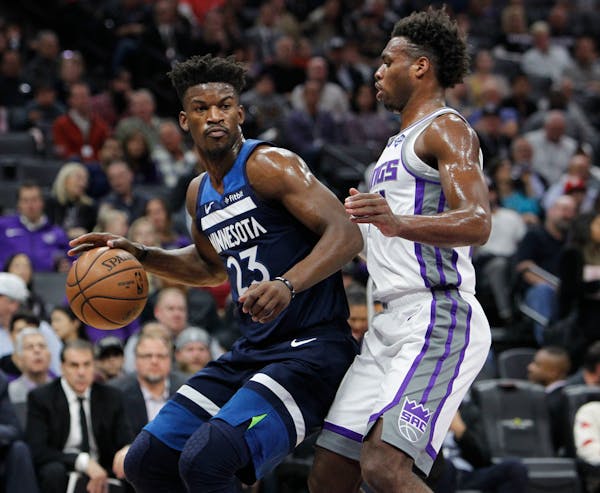Through 12 games this season, the Timberwolves were ranked dead last in the NBA in defensive rebounding percentage — a stat that tabulates the percentage of available defensive rebounds a team corrals.
The Wolves had grabbed just 66.4 percent — a little less than two of every three — after getting a not great but much better 72 percent last season.
Since poor rebounding has been a culprit in multiple losses already this season, the question today is this: Why has Minnesota struggled so much in that area?
First take: Michael Rand
Like many things wrong so far with this year's Wolves, the answer is probably a complicated combination of effort — perhaps brought on by the strange dynamic created by Jimmy Butler's continued presence after a trade request — personnel, league trends and sample size.
I'll start with a big one, though: Their primary starting guards and small forward have been quite poor in this area. Jimmy Butler's rebound percentage (9.4) and that of Andrew Wiggins (9.2) are unacceptably low, while their point guards are all under 7 percent. Nobody is expecting Russell Westbrook (23 percent!), but that's a huge gap.
As teams shoot more three-pointers — Wolves opponents are averaging about three more attempts from long distance this year vs. last year — rebounds get longer and a full five-player effort becomes crucial.
Chris Hine: It's mystifying why the Wolves aren't better in this area. It's not as if they're playing small. Karl-Anthony Towns certainly has height, so does Taj Gibson, and Andrew Wiggins has athletic ability for days. I suppose you have to condition the guards to rebound on a more consistent basis.
Guards aren't accustomed to boxing out the players they're guarding on the perimeter. Also, there's a tradeoff. If a guard stays in to box out, it might prevent the Wolves' ability to get out in transition. Perhaps they have to worry less about transition and more about securing the rebounds in the first place.
Rand: Some lopsided totals have skewed the stats, but it's hard not to think effort has something to do with it. After all, there wasn't that much roster turnover from last year to this year before Saturday's Butler trade.
If we look just at rebound differential, the Wolves were a little on the plus side a year ago, grabbing 0.2 boards more than opponents (No. 17 in the league). This year they're minus-7.9 (No. 29 in the league). Maybe playing a tough early schedule has something to do with it, but that doesn't explain all of it.
Hine: Rebounding is mostly effort, so ultimately the Wolves have nobody but themselves to blame for this. You can make excuses about long rebounds and the schedule or whatever else, but rebounding will always be about effort.
The defender is almost always between his man and the basket. Box him out and even if it's a long rebound, you have a good shot of bringing it down.
Rand: Speaking of boxing out, the Wolves were dead last in that stat a year ago before it mysteriously disappeared from the NBA.com advanced stats page. I'd love to know where they rank now.
Hine: That would be 27th at 25.2 per game! Nice job setting me up.
More Rand: startribune.com/RandBall
More North Score: startribune.com/NorthScore
Police clear out a migrant camp in central Paris. Activists say it's a pre-Olympics sweep

Towns finding joy trying to stop 'best of the best' in Durant

Vikings' need at linebacker is low, but depth is concern

